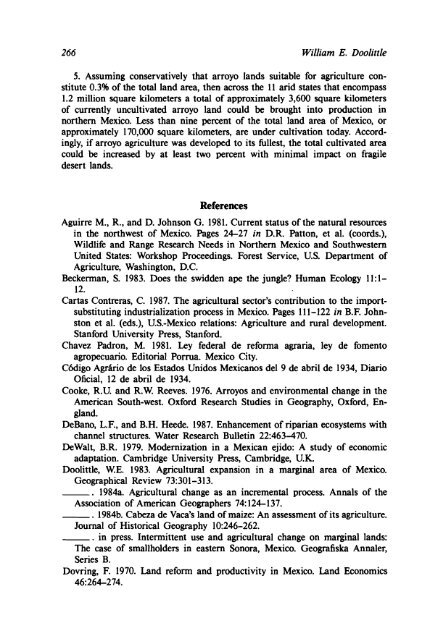Fragile Lands of Latin America Strategies for ... - PART - USAID
Fragile Lands of Latin America Strategies for ... - PART - USAID
Fragile Lands of Latin America Strategies for ... - PART - USAID
You also want an ePaper? Increase the reach of your titles
YUMPU automatically turns print PDFs into web optimized ePapers that Google loves.
266 William E. Doolirtle<br />
5. Assuming conservatively that arroyo lands suitable <strong>for</strong> agriculture con-<br />
stitute 0.3% <strong>of</strong> the total land area, then across the 11 arid states that encompass<br />
1.2 million square kilometers a total <strong>of</strong> approximately 3,600 square kilometers<br />
<strong>of</strong> currently uncultivated arroyo land could be brought into production in<br />
northern Mexico. Less than nine percent <strong>of</strong> the total land area <strong>of</strong> Mexico, or<br />
approximately 1 70,000 square kilometers, are under cultivation today. Accord-<br />
ingly, if arroyo agriculture was developed to its hllest, the total cultivated area<br />
could be increased by at least two percent with minimal impact on fragile<br />
desert lands.<br />
References<br />
Aguirre M., R., and D. Johnson G. 1981. Current status <strong>of</strong> the natural resources<br />
in the northwest <strong>of</strong> Mexico. Pages 24-27 in D.R. Patton, et al. (coords.),<br />
Wildlife and Range Research Needs in Northern Mexico and Southwestern<br />
United States: Workshop Proceedings. Forest Service, U.S. Department <strong>of</strong><br />
Agriculture, Washington, D.C.<br />
Beckerman, S. 1983. Does the swidden ape the jungle? Human Ecology 11:l-<br />
12.<br />
Cartas Contreras, C. 1987. The agricultural sector's contribution to the import-<br />
substituting industrialization process in Mexico. Pages 11 1-122 in B.F. John-<br />
ston et al. (eds.), U.S.-Mexico relations: Agriculture and rural development.<br />
Stan<strong>for</strong>d University Press, Stan<strong>for</strong>d.<br />
Chavez Padron, M. 1981. Ley federal de re<strong>for</strong>ma agraria, ley de foment0<br />
agropecuario. Editorial Porma. Mexico City.<br />
C6digo Agrhio de 10s Estados Unidos Mexicanos del 9 de abril de 1934, Diario<br />
Oficial, 12 de abril de 1934.<br />
Cooke, R.U. and R.W. Reeves. 1976. Arroyos and environmental change in the<br />
<strong>America</strong>n South-west. Ox<strong>for</strong>d Research Studies in Geography, Ox<strong>for</strong>d, En-<br />
gland.<br />
DeBano, L.F., and B.H. Heede. 1987. Enhancement <strong>of</strong> riparian ecosystems with<br />
channel structures. Water Research Bulletin 22:463-470.<br />
DeWalt, B.R. 1979. Modernization in a Mexican ejido: A study <strong>of</strong> economic<br />
adaptation. Cambridge University Press, Cambridge, U.K.<br />
Doolittle, W.E. 1983. Agricultural expansion in a marginal area <strong>of</strong> Mexico.<br />
Geographical Review 73:301-313.<br />
. 1984a. Agricultural change as an incremental process. Annals <strong>of</strong> the<br />
Association <strong>of</strong> <strong>America</strong>n Geographers 74: 124- 1 37.<br />
. 1984b. Cabeza de Vaca's land <strong>of</strong> maize: An assessment <strong>of</strong> its agriculture.<br />
Journal <strong>of</strong> Historical Geography 10:246-262.<br />
. in press. Intermittent use and agricultural change on marginal lands:<br />
The case <strong>of</strong> smallholders in eastern Sonora, Mexico. Geografiska Annaler,<br />
Series B.<br />
Dovring, F. 1970. Land re<strong>for</strong>m and productivity in Mexico. Land Economics<br />
46:264-274.

















